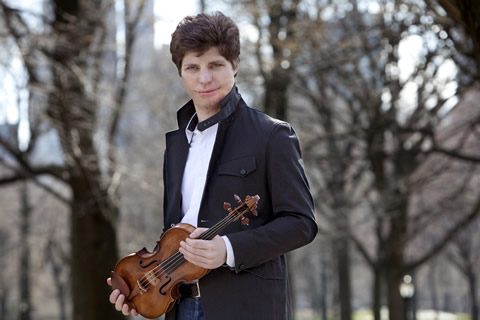Dmitri Sitkovetsky, music director of the Greensboro Symphony Orchestra and international violin virtuoso, has a long history of making creative transcriptions of keyboard works of Johann Sebastian Bach (1685-1750) for string instruments. His imaginative approach is described in the program note to his 1985 Orfeo recording of his string trio version of the Goldberg Variations, S. 988: “The parts for violin, viola, and cello are not divided in the context of a Baroque string ensemble supported by a basso continuo. The three equal partners function here like the different registers of a single instrument.” Sitkovetsky’s string version has been very widely performed.
This Rice Toyota Sitkovetsky & Friends season finale concert took place in the intimate and warm acoustics of the Recital Hall of the University of North Carolina Greensboro. It featured cello concerto soloist Zuill Bailey with Sitkovetsky on violin on both works performed. The other musicians were principal players in the orchestra. In prefatory remarks from the stage, Sitkovetsky said he had been preparing to make a new recording of his string trio version of the Goldberg Variations and needed something to fill out the disc. He had made a string transcription of Bach’s Two-Part and Three-Part Inventions and found the later 15 Sinfonias (S. 787-801) a perfect fit. In addition to equal treatment of the three instruments, he said he had “toyed” with the parts to add virtuoso effects. Most of the fifteen pieces are under 2 minutes in length.
The players for the string trio arrangement of Bach’s Three-Part Inventions were violinist Sitkovetsky, principal violist Scott Rawls, and Bailey. Intonation was excellent. String tone was rich and warm while their use of dynamics was refined. The clarity of contrapuntal lines was a constant pleasure. I have a fondness for the harpsichord’s lute stop. Perhaps that was the origin of the delightful juxtaposition of the cello’s pizzicatos in No. 5 against the singing duet of the violin and viola. Every invention had some winning aspect.
The concert ended with a teaser, a performance of four of the six movements of the Serenade No.1 in D, Op. 11 by Johannes Brahms (1833-97). Brahms originally scored the piece as a nonet for winds and strings in 1857. Recognizing the orchestral character of the work, he expanded it for woodwinds in pairs, four horns, two trumpets, timpani, and strings. The composer destroyed most of the score but modern composer Alan Boustead has reconstructed the original nonet version for violin, viola, cello, double-bass, flute, two clarinets, bassoon, and French horn.
The full six movements would have run over 45 minutes. Promising a future performance of the full-sized orchestra version by the GSO, Sitkovetsky omitted the second and third movements (a Scherzo and Adagio) choosing the opening Allegro moto, fourth movement Menuettos I and II, fifth movement Scherzo, and the Rondo Allegro finale. The players were violinist Sitkovetsky, violist Rawls, cellist Bailey, with double-bassist John Spuller, flutist Debra Reuter-Pivetta, clarinetists Kelly Burke and Ed Riley, bassoonist Carol Bernsdorf, and Bob Campbell on French horn.
This partial performance of the reconstructed nonet version of Op. 11 was charming with its suggestion of hunting serenades. Campbell spun out superbly the Haydn-like horn tune early in the first movement. The outdoorsy quality of the work, especially in the opening movement, was perfectly conjured up by the ensemble. Every player contributed considerably to boisterous spirits of the serenade with individual and ensemble playing of the highest quality.
It is too bad Op. 11 is the least performed of Brahms’ orchestral works. It was last heard in this area when Leonard Slatkin programed it when his Saint Louis Symphony toured in Spring 1986 at Duke University’s Page Auditorium, among others.
This concert was preceded by a concert featuring a string orchestra from Penn-Griffin School for the Arts in High Point. Each year the musicians of the GSO perform a two-week residency coaching students at three of the local high schools annually. This string orchestra performed without conductor with GSO principal players leading each string section. The display of talent was promising. The hard surfaces and overhang of the lobby tended to act as an amplifier. Perhaps some soft rugs could soften the sound in the future?














